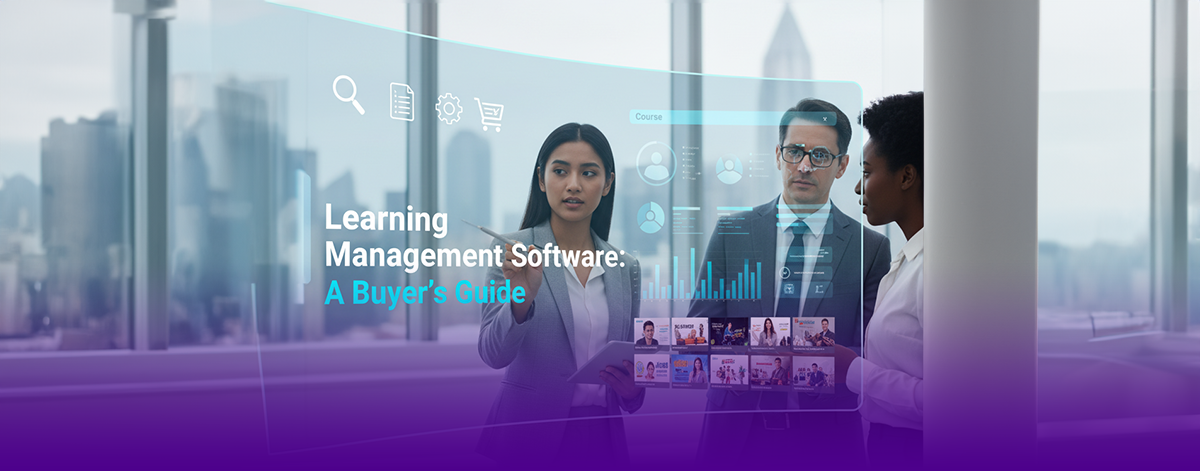
Extended Enterprise LMS: Training Beyond Your Workforce
October 31, 2025
The Workforce Wake-Up Call: Why Organizations Must Act Now on Skills, Retention, and ROI
October 10, 2025If you’ve ever tried to organize training for a team, whether it’s five people or five thousand, you know it can get messy fast. Emails with links, scattered resources, and endless spreadsheets to track progress – it doesn’t take long before things feel out of control. That’s precisely why learning management software exists.
An LMS puts all of those moving pieces under one roof. It’s the hub where your courses live, where employees log in to learn, and where you, as a leader, can see exactly how training is making an impact. In short, it’s the backbone of any modern corporate training system.
But here’s the challenge: Not all LMS software is created equal. Some are simple, lightweight tools for small teams. Others are enterprise-grade systems packed with integrations, analytics, and automation. And with so many vendors making big promises, figuring out which LMS software is right for your organization can feel overwhelming.
We’ll break down what learning management software does, the features to look for, the types of systems available, and the trends shaping the future. Most importantly, you’ll get practical advice on how to evaluate options so you can invest in a platform that supports your people and drives tangible business outcomes.
What is Learning Management Software?
Learning management software is a digital platform designed to plan, deliver, and track training and educational programs. Think of it as the backbone of a modern corporate training system, centralizing all aspects of employee learning into one accessible hub.
At its core, LMS software enables organizations to:
- Create and deliver courses in multiple formats (videos, quizzes, e-learning modules).
- Track learner progress and completion.
- Measure knowledge through assessments and certifications.
- Generate data-driven insights about workforce skill development.
The beauty of learning tools within an LMS is that they support a variety of use cases from onboarding new employees and ensuring compliance to delivering leadership programs and continuous professional development. For learners, an LMS provides a flexible, personalized way to learn at their own pace. For businesses, it creates a measurable impact aligned with organizational goals.
Why Learning Management Software is Essential for Modern Businesses
Organizations view training as a continuous journey that drives performance, innovation, and retention. Here’s why learning management software is indispensable today:
- Scalability: Whether training 100 employees or 10,000, LMS software scales seamlessly, eliminating the logistical barriers of traditional classroom learning.
- Consistency: It ensures that employees across geographies receive the same training standards, especially crucial for compliance.
- Personalization: With AI-driven pathways, employees can access learning that matches their roles, goals, and skill gaps.
- Measurement: Unlike classroom sessions where impact is hard to measure, LMS platforms provide granular data on progress, engagement, and outcomes.
- Integration with Workflows: Modern corporate training systems integrate with HR, CRM, and collaboration tools, embedding learning directly into daily work.
Key Features to Look for in Learning Management Software
Before investing, you need to evaluate which capabilities matter most to your organization. The best LMS software typically offers:
- Course Creation and Content Management: The foundation of any LMS lies in its ability to host and manage diverse training content. Look for platforms that support multiple formats: SCORM, xAPI, videos, PDFs, podcasts, and simulations. Advanced systems also allow the curation of external content like LinkedIn Learning or Coursera.
- Learner-Centric Design: A good LMS should feel intuitive, mobile-friendly, and engaging. Features such as gamification, social learning communities, and personalized dashboards keep learners motivated.
- Analytics and Reporting: Data is the backbone of modern learning. Strong learning tools include dashboards that track course completions, assessment scores, time spent learning, and even correlations to performance outcomes.
- Integration Capabilities: Your corporate training system shouldn’t exist in isolation. Ensure the LMS integrates smoothly with HR software, Single Sign-On (SSO), collaboration apps like Microsoft Teams or Slack, and performance management tools.
- Automation: Automated notifications, reminders, and learning assignments reduce administrative workload and ensure training stays on track.
- Compliance Management: For industries like healthcare, finance, and manufacturing, compliance is non-negotiable. LMS software should generate audit-ready reports and provide certification tracking.
- Scalability and Security: With rising data privacy concerns, your LMS must have enterprise-level security and scalability to accommodate future growth.
Types of Learning Management Software
Depending on your needs, you’ll encounter several types:
- Cloud-Based LMS Software: Hosted on the vendor’s servers, easy to set up, and scalable. Ideal for most organizations.
- Self-Hosted LMS: Installed on your organization’s servers, giving more control but requiring IT resources.
- Open-Source LMS: Free to use and customizable, but needs technical expertise (e.g., Moodle).
- Enterprise LMS Solutions: Comprehensive platforms tailored for large corporations, offering advanced analytics, integrations, and compliance features.
- Specialized LMS Platforms: Focused on specific use cases like customer training, sales enablement, or partner education.
How to Choose the Right LMS Software
Choosing the right learning management software isn’t just about features; it’s about fit. Here’s a step-by-step guide:
Step 1: Define Your Objectives
- Are you focused on compliance?
- Do you need to onboard faster?
- Are leadership development and continuous learning priorities?
Clarity here ensures you don’t overpay for unnecessary features.
Step 2: Engage Stakeholders:
Bring in HR, IT, managers, and employees to explain pain points and must-have features.
Step 3: Compare Vendors
Evaluate multiple LMS software vendors. Shortlist based on pricing, scalability, support, and alignment with your objectives.
Step 4: Ask About Support and Training
Adopting a new corporate training system requires changing management. Ensure the vendor provides onboarding support, admin training, and responsive customer service.
Step 5: Pilot and Test
Run a pilot program with a small team before committing organization-wide. Collect feedback on usability, learner experience, and reporting accuracy.
The ROI of Learning Management Software
Investing in an LMS is not just about cost; it’s about measurable returns. Here’s how to assess ROI:
- Reduced Training Costs: Save on travel, venue, and instructor fees.
- Improved Productivity: Faster onboarding and skill ramp-up mean employees contribute sooner.
- Compliance Risk Reduction: Minimized penalties or incidents with better training records.
- Retention and Engagement: Employees who feel invested in tend to stay longer.
- Business Impact: Advanced analytics can correlate training with revenue, customer satisfaction, or innovation metrics.
Conclusion
The right learning management software has the power to shape how your organization learns, grows, and succeeds. With Tenneo’s AI-powered LMS, you gain a more innovative way to build skills, engage employees, and drive measurable business outcomes.
Tenneo LMS features advanced analytics and personalization to make learning seamless and impactful. It adapts to your workforce needs, scales effortlessly, and empowers leaders with insights that connect learning directly to performance.
If you’re still exploring the best-suited intuitive learning tool for your workforce, contact our experts at Tenneo.



